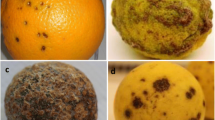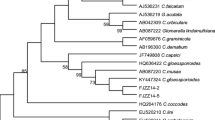Abstract
The present study reports the development and evaluation of a hemi-nested polymerase chain reaction (hnPCR) assay for the efficient detection of ‘Candidatus Liberibacter’ infecting citrus plants. A set of new primers was designed by alignment of nucleotide sequences of the β-operon (rplKAJL-rpoBC) ribosomal protein genes from all the known ‘Candi-datus Liberibacter asiaticus’ isolates reported in Genbank. Hemi-nested PCR reaction components and thermal cycling parameters were optimized and reaction conditions were standardized. Sequencing of the PCR products from hemi nested-PCR reactions confirmed the specificity of new primer pairs for ‘Candidatus Liberibacter asiaticus’. The reliability and sensitivity of hnPCR was evaluated by comparing it to real-time PCR.
Similar content being viewed by others
References
Adkar-Purushothama CR, Quaglino F, Casati P & Bianco PA, 2010. Reverse transcription-duplex-polymerase chain reaction for simultaneous detection of Citrus tristeza virus and ‘Candidatus Liberibacter’ from citrus plants. J Plant Dis Protect 117, 241–243.
Bové JM, 2006. Huanglongbing: a destructive, newly-emerging, century-old disease of citrus. J Plant Pathol 88, 7–37.
Catling HD, Garnier M & Bové JM, 1978. Presence of citrus greening disease in Bangladesh and a new method for rapid diagnosis. FAO Plant Protect Bulletin 26, 16–18.
Ding F, Wang G, Yi G, Zhong Y, Zeng J & Zhou B, 2005. Infection of wampee and lemon by the citrus huanglongbing pathogen (Candidatus Liberibacter asiaticus) in China. J Plant Pathol 87, 207–212.
Donnua S, Ampaiwan P, Chowpongpang S & Thaveechai N, 2012. Comparison between single and duplex conventional PCR for detection of Candidatus Liberibacter asiati-cus, the causal agent of citrus Huanglongbing disease in Thailand. Crop Protect 41, 128–133.
Fujikawa T & Iwanami T, 2012. Sensitive and robust detection of citrus greening (huanglongbing) bacterium ‘Candidatus Liberibacter asiaticus’ by DNA amplification with new 16S rDNA-specific primers. Mol Cell Probe 26, 194–197.
Fujikawa T, Miyata S-I & Iwanami T, 2013. Convenient detection of the citrus greening (huanglongbing) bacterium ‘Candidatus Liberibacter asiaticus’ by direct PCR from the midrib extract. PLoS ONE 8(2): e57011. doi:10.1371/ journal.pone.0057011.
Graça da JV, 1991. Citrus greening disease. Ann Rev Phytopatho 29, 109–136.
Hocquellet A, Toorawa P, Bové JM & Garnier M, 1999. Detection and identification of the two ‘Candidatus Liberib-acter’ species associated with citrus huanglongbing by PCR amplification of ribosomal protein genes of the β-operon. Mol Cell Probes 13, 373–379.
Hoy MA, Jeyaprakash A & Nguyen R, 2001. Long PCR is a sensitive method for detecting Liberibacter asiaticum in parasitoids undergoing risk assessment in quarantine. Biol Control 22, 278–287.
Jagoueix S, Bové J-M & Garnier M, 1994. The phloem-limited bacterium of greening disease of citrus is a member of the alpha subdivision of the proteobacteria. Int J Syst Bacteriol 44, 379–386.
Jagoueix S, Bové J-M & Garnier M, 1996. PCR detection of the two ‘Candidatus’ liberibacter species associated with greening disease of citrus. Mol Cell Probes 10, 43–50.
Li W, Hartung JS & Levy L, 2006. Quantitative real-time PCR for detection and identification of ‘Candidatus Liberibacter’ species associated with citrus Huanglongbing. J Microbiol Meth 66, 104–115.
Li W, Abad JA, French-Monar RD, Rascoe J, Wen A, Gudmestad NC, Secor GA, Lee I-M, Duan Y & Levy L, 2009. Multiplex real-time PCR for detection, identification and quantification of ‘Candidatus Liberibacter solanacearum’ in potato plants with zebra chip. J Microbiol Method 78, 59–65.
Loconsole G, Saponari M & Savino V, 2010. Development of real- time PCR based assays for simultaneous and improved detection of citrus viruses. Eur J Plant Pathol 128, 251–259.
Mackay I, Arden K & Nitsche A, 2002. Real-time PCR in virology. Nucl Acids Res 30, 1292–1305.
Morgan JK, Zhou L, Li W, Shatters RG, Keremane M & Duan YP, 2012. Improved real-time PCR detection of ‘Candidatus Liberibacter asiaticus’ from citrus and psyllid hosts by targeting the intragenic tandem-repeats of its prophage genes. Mol Cell Probes 26, 90–98.
Pietersen G, Arrebola E, Breytenbach JHJ, Korsten L, le Roux HF, la Grange H, Lopes SA, Meyer JB, Pretorius MC, Schwerdtfeger M, van Vuuren SP & Yamamoto P, 2010. A survey for ‘Candidatus Liberibacter’ species in South Africa confirms the presence of only ‘Ca. L. africanus’ in commercial citrus. Plant Dis 94, 244–249.
Tatineni S, Sagaram US, Gowda S, Robertson CJ, Dawson WO, Iwanami T & Wang N, 2008. In planta distribution of ‘Candidatus Liberibacter asiaticus’ as revealed by polymerase chain reaction (PCR) and Real-Time PCR. Phytopathology 98, 592–599.
Thompson JD, Higgins DG & Gibson TJ, 1994. CLUSTAL W: improving the sensitivity of progressive multiple sequence alignment through sequence weighting, position-specific gap penalties and weight matrix choice. Nucl Acids Res 22, 4673–4680.
Urasaki N, Kawano S, Mukai H, Uemori T, Takeda O & Sano T, 2008. Rapid and sensitive detection of ‘Candidatus Liberi-bacter asiaticus’ by cycleave isothermal and chimeric primer-initiated amplification of nucleic acids. J Gen Plant Pathol 74, 151–155.
Varma A, Ahlawat YS, Chakraborty NK, Garnier M & Bové JM, 1993. Detection of the greening BLO by electron microscopy, DNA hybridization and ELISA in citrus leaves with and without mottle from various regions in India. In: Moreno P, Graça da JV & Timmer LW, (eds.) Proceedings of 12th Conference IOCV, Riverside, CA 1993, 280–286.
Author information
Authors and Affiliations
Corresponding author
Rights and permissions
About this article
Cite this article
Bhaskara, A.S., Ahmed, B.N.J., Adkar-Purushothama, C.R. et al. Evaluation of efficiency of hemi-nested PCR assay for the detection of ‘Candidatus Liberibacter’ infecting citrus. J Plant Dis Prot 120, 189–193 (2013). https://doi.org/10.1007/BF03356473
Received:
Accepted:
Published:
Issue Date:
DOI: https://doi.org/10.1007/BF03356473




